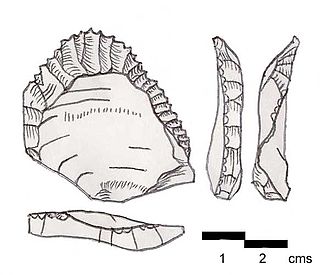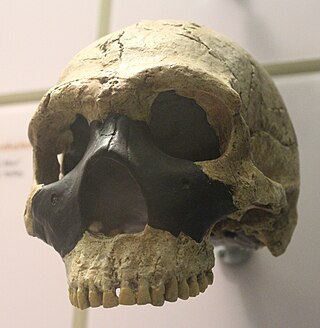
The Red "Lady" of Paviland is an Upper Paleolithic partial male skeleton dyed in red ochre and buried in Wales 33,000 BP. The bones were discovered in 1823 by William Buckland in an archaeological dig at Goat's Hole Cave which is a limestone cave between Port Eynon and Rhossili on the Gower Peninsula, near Swansea in south Wales. Buckland believed the skeleton was a Roman era female. Later, William Solace examined Goat's Cave Paviland in 1912. There, Solace found flint arrow heads and tools and correctly concluded that the skeleton was in fact a male hunter-gatherer or warrior during the last Ice Age.
The Middle Paleolithic is the second subdivision of the Paleolithic or Old Stone Age as it is understood in Europe, Africa and Asia. The term Middle Stone Age is used as an equivalent or a synonym for the Middle Paleolithic in African archeology. The Middle Paleolithic broadly spanned from 300,000 to 50,000 years ago. There are considerable dating differences between regions. The Middle Paleolithic was succeeded by the Upper Paleolithic subdivision which first began between 50,000 and 40,000 years ago. Pettit and White date the Early Middle Paleolithic in Great Britain to about 325,000 to 180,000 years ago, and the Late Middle Paleolithic as about 60,000 to 35,000 years ago. The Middle Paleolithic was in the geological Chibanian and Late Pleistocene ages.

Kebara Cave is a limestone cave locality in Wadi Kebara, situated at 60 to 65 m above sea level on the western escarpment of the Carmel Range, in the Ramat HaNadiv preserve of Zichron Yaakov.

The Tabun Cave is an excavated site located at Nahal Me'arot Nature Reserve, Israel and is one of the Human Evolution sites at Mount Carmel, which were proclaimed as having universal value by UNESCO in 2012.

Es-Skhul or the Skhul Cave is a prehistoric cave site situated about 20 kilometres south of the city of Haifa, Israel, and about 3 km (1.9 mi) from the Mediterranean Sea.

Teshik-Tash 1 is a Neanderthal skeleton discovered in 1938 in Teshik-Tash Cave, in the Bajsuntau mountain range, Uzbek SSR (Uzbekistan), Central Asia.
Baruch Arensburg, professor of Anatomy, Sackler School of Medicine, Tel-Aviv University (emeritus), is a physical anthropologist whose main field of study has been prehistoric and historic populations of the Levant.

Ksar Akil is an archeological site 10 km (6.2 mi) northeast of Beirut in Lebanon. It is located about 800 m (2,600 ft) west of Antelias spring on the north bank of the northern tributary of the Wadi Antelias. It is a large rock shelter below a steep limestone cliff.

Mount Precipice, also known as Mount of Precipitation, Mount of the Leap of the Lord and Mount Kedumim is located just outside the southern edge of Nazareth, 2.0 km southwest of the modern city center.

Qesem cave is a Lower Paleolithic archaeological site near the town of Kafr Qasim in Israel. Early humans were occupying the site by 400,000 until c. 200,000 years ago.

The Skhul and Qafzeh hominins or Qafzeh–Skhul early modern humans are hominin fossils discovered in Es-Skhul and Qafzeh caves in Israel. They are today classified as Homo sapiens, among the earliest of their species in Eurasia. Skhul Cave is on the slopes of Mount Carmel; Qafzeh Cave is a rockshelter near Nazareth in Lower Galilee.

Mugharet el-Zuttiyeh is a prehistoric archaeological site in Upper Galilee, Israel. It is situated 800 m (2,600 ft) from the Nahal Amud outlet, approximately 30 m (98 ft) above the wadi bed. It was found to house a fossil today known as the "Galilee skull" or "The Yabrudian Man".

The Caves of Nahal Me’arot / Wadi el-Mughara, named here by the Hebrew and Arabic name of the valley where they are located, are a UNESCO Site of Human Evolution in the Carmel mountain range near Haifa in northern Israel.
Manot 1 is a fossil specimen designated to a skullcap that represents an archaic modern human discovered in Manot Cave, Western Galilee, Israel. It was discovered in 2008 and the scientific description was published in 2015. Radiometric dating indicates that it is about 54,700 years old, and thought to be directly ancestral to the Upper Paleolithic populations of the Levant and Europe.

Southwest Asian Neanderthals were Neanderthals who lived in Turkey, Lebanon, Syria, Israel, Palestine, Iraq, and Iran - the southernmost expanse of the known Neanderthal range. Although their arrival in Asia is not well-dated, early Neanderthals occupied the region apparently until about 100,000 years ago. At this time, Homo sapiens migration seem to have replaced them in one of the first anatomically-modern expansions out of Africa. In their turn, starting around 80,000 years ago, Neanderthals seem to have returned and replaced Homo sapiens in Southwest Asia. They inhabited the region until about 55,000 years ago.

Amud 1 is a nearly complete but poorly preserved adult Southwest Asian Neanderthal skeleton thought to be about 55,000 years old. It was discovered at Amud in Israel by Hisashi Suzuki in July 1961, who described it as male. With an estimated height of 1.78 m, it is considerably taller than any other known Neanderthal, and its skull has by far the largest cranial capacity of any human skull in the fossil record. According to Ralph Holloway, this makes it one of the most famous Neanderthal specimens.

Kebara 2 is a 61,000 year-old Levantine Neanderthal mid-body male skeleton. It was discovered in 1983 by Ofer Bar-Yosef, Baruch Arensburg, and Bernard Vandermeersch in a Mousterian layer of Kebara Cave, Israel. To the excavators, its disposition suggested it had been deliberately buried, though like every other putative Middle Palaeolithic intentional burial, this has been questioned.

Le Regourdou is an archaeological site in the Dordogne department, France, on top of a hill just 800 m (2,600 ft) from the famous cave complex of Lascaux. At this now collapsed 35 m (115 ft) deep ancient karst cavity remarkably well preserved Neanderthal fossils were recovered, that might be skeletal remains of deliberate burials. According to the current excavation team at the site, the correct name of the location is "Regourdou". "Le Régourdou" is considered a misnomer and should be avoided.
Erella Hovers is an Israeli paleoanthropologist. She is currently a professor at The Hebrew University of Jerusalem, working within the Institute of Archeology. The majority of her field work is centered in the Horn of Africa, with a primary focus on Ein Qashish, Israel and Eastern Ethiopia. Her research concentrates on the development of the use of symbolism during the Levantine Middle Palaeolithic and Middle Stone Age. Other research interests include lithic technology, taphonomy, and general behavior of early hominids.















